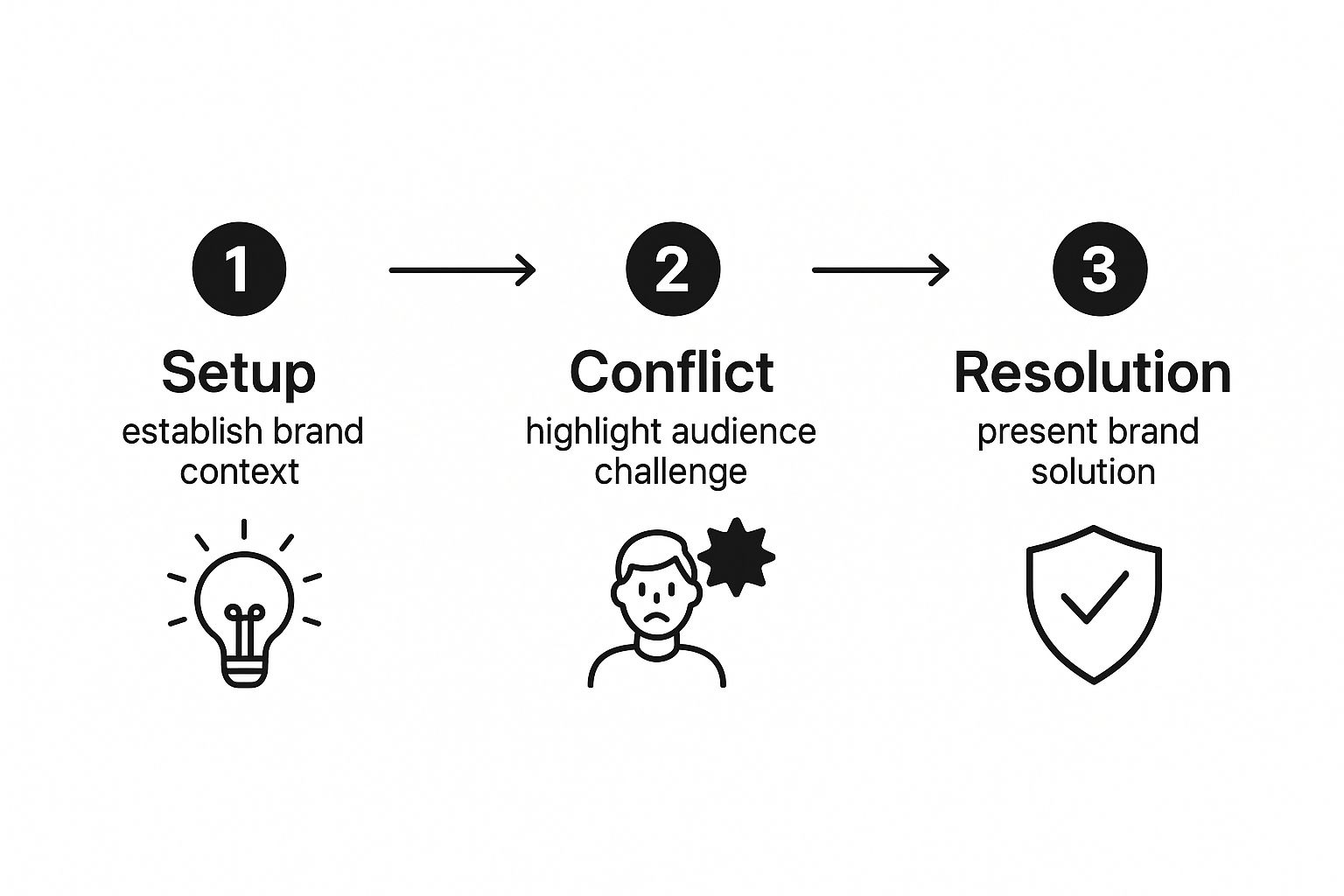Understanding What Makes Modern Brand Stories Actually Work

Let's face it: many brand stories simply don't stick. They lack the depth and genuine connection needed to resonate with audiences, getting lost in the constant barrage of marketing messages. So, what sets apart the narratives that truly connect? It all comes down to a powerful brand storytelling framework.
The Importance of Conflict in Narrative
A key ingredient in captivating storytelling is conflict. Think about your favorite stories; they always revolve around a central struggle or challenge. This conflict creates tension, drawing the audience in and making them care about the resolution. Brand storytelling is no different.
By incorporating relevant conflicts, you forge an emotional link with your audience. Your story becomes relatable and memorable, rising above generic marketing.
For example, a sustainable clothing brand could highlight the conflict between fast fashion and environmentalism. Showcasing this tension positions the brand as a solution, attracting eco-conscious consumers. Learn more about understanding your audience: How to master audience understanding.
Building a Framework Around Core Values
A winning brand storytelling framework hinges on your core values. These values are the bedrock of your business, shaping your brand identity and guiding decisions. Weaving them into your narrative creates authenticity and purpose, building trust with your audience.
Brand storytelling has come a long way. It now embraces various frameworks and dimensions to maximize impact. A corporate model might incorporate four dimensions: story, meaning, ritual, and transmedia. This allows for cohesive narratives across platforms, deepening audience connection. The use of storytelling in marketing is booming, with U.S.-based searches for "storytelling marketing" increasing by more than threefold in September 2024 compared to the previous year. Explore this further: Storytelling Marketing Research. A robust framework ensures consistency across all touchpoints, amplifying your message and creating a lasting impression.
Focusing on Emotional Triggers
Understanding emotional triggers is crucial. Human decisions are often driven by emotions, not just logic. By incorporating these triggers into your brand story, you can create a deeper connection with your audience.
This isn't about manipulation; it's about understanding your customers' motivations and crafting a narrative that resonates with their values, aspirations, and needs. It’s about creating a story they feel, not just hear.
The Science Behind Why Stories Actually Change Minds

Have you ever noticed how a simple jingle can stick in your mind for days, while a detailed product description vanishes almost instantly? This isn't random; it's rooted in the way our brains work. We're wired to connect with stories on a deeper level than with pure information. This is the core principle driving a powerful brand storytelling framework.
The Neurological Impact of Narrative
When we listen to a story, various areas of our brains become active. We don't just passively absorb information; we actively experience it. This engagement triggers emotional responses, making the message far more memorable and persuasive.
For instance, a story about overcoming challenges activates the same brain regions we use when recalling personal experiences. This creates powerful feelings of empathy and connection.
Emotions: The Key to Connection
Emotions are essential to how we understand and react to stories. Facts are important, of course, but they often lack the emotional depth to truly resonate with an audience.
That's where a thoughtful brand storytelling framework comes into play. A compelling narrative can evoke feelings of trust, excitement, or even nostalgia, making your brand more relatable and memorable. Consider exploring resources like How to master brand storytelling with examples to deepen your understanding.
Authenticity and Trust
Authenticity is paramount. Audiences can quickly detect a fabricated story, and this can severely damage trust and credibility. A genuine narrative, aligned with your brand's core values, has a far greater impact. This authenticity builds the foundation for strong, enduring relationships with your audience.
One of the most compelling benefits of brand storytelling is its potential to boost conversions. Brands using storytelling effectively can see a 30% increase in conversion rates. Storytelling makes messages relatable, and people are 22 times more likely to remember information presented within a narrative. Explore Storytelling Marketing Statistics for further insights. The power of narrative transcends simple recall; it shapes our viewpoints and guides our choices.
Building Your Brand Storytelling Framework From Scratch
Ready to weave a brand story that truly captivates? This guide illuminates the path, from initial inspiration to a framework that breathes life into your brand. Discover how to unearth your brand's unique narrative elements, shape relatable character archetypes, and construct engaging story arcs that resonate with your audience throughout their journey with you.
Identifying Your Brand's Core Narrative
Begin by delving into the heart of your brand. What values define you? What challenges do you help your customers overcome? What sets you apart? Your answers to these questions become the bedrock of your brand storytelling framework. This goes beyond superficial slogans. It means uncovering the deep-seated beliefs and motivations that propel your brand forward. For instance, if your brand champions ethical sourcing, explore the specific steps you take to ensure this and how these actions directly benefit your customers.
Developing Relatable Character Archetypes
Every compelling story needs captivating characters. In brand storytelling, these characters embody your ideal customers. Crafting detailed character archetypes illuminates your audience's needs, desires, and pain points. This deeper understanding enables you to create narratives that genuinely connect. Think beyond demographics. Consider their psychographics – their values, interests, and lifestyles. By understanding their motivations, you craft characters they recognize themselves in.
Crafting Engaging Story Arcs
Your brand storytelling framework thrives on a clear narrative structure, or story arc. A classic story arc encompasses a setup, conflict, resolution, and an emotional payoff. This structure provides a compelling framework for demonstrating how your brand empowers customers to conquer challenges and achieve their aspirations. Imagine it like crafting a captivating plot for a novel, adapted to your brand and customer journey. The infographic below visualizes the core components of this storytelling framework:

This infographic illustrates the journey from establishing your brand's context (setup) to highlighting your audience's challenges (conflict) and finally presenting your brand as the solution (resolution). By framing your narrative around these key elements, you provide context, build empathy, and offer a clear path forward. This structure creates a powerful foundation for engaging and persuasive brand storytelling.
Organizing Your Storytelling Strategy With Practical Tools
To maintain a consistent and effective narrative, leverage valuable tools. These might include content planning systems like Asana, narrative guidelines, and brand voice documentation. These tools ensure consistent messaging across all platforms and empower everyone in your organization to understand and apply your brand storytelling framework. This fosters brand recognition and amplifies your message. Think of these tools as the conductor of an orchestra, harmonizing every instrument to create a symphony of brand storytelling. This cohesive approach transforms scattered messages into a unified, impactful narrative that propels your business goals.
To further understand the nuances of different storytelling frameworks, consider the following comparison:
Brand Storytelling Framework Components Comparison: A detailed comparison of different storytelling framework approaches, showing the key elements and benefits of each methodology.
| Framework Type | Core Elements | Best Use Cases | Implementation Complexity |
|---|---|---|---|
| Hero's Journey | Setup, Conflict, Resolution, Return | Building an emotional connection with the audience, showcasing brand values | Medium |
| Three-Act Structure | Setup, Confrontation, Resolution | Product launches, campaigns with a clear beginning, middle, and end | Low |
| Mountain Structure | Rising Action, Climax, Falling Action | Building suspense and excitement, highlighting a key moment or achievement | Medium |
| In Medias Res | Starting in the middle of the action | Capturing attention quickly, creating intrigue | High |
This table highlights how various framework types offer unique approaches to storytelling, each with its own ideal use cases and implementation complexity. Choosing the right framework depends on your specific brand story and goals. From the straightforward Three-Act Structure to the more complex In Medias Res, understanding the core elements allows you to craft a compelling and effective narrative.
Crafting Stories That Actually Drive Business Results

Let's move past the theoretical and dive into the practical magic of brand storytelling. This is about crafting narratives that not only capture hearts but also drive conversions. It's about transforming everyday brand messages into compelling stories that deliver real, tangible results.
Structuring Your Story for Maximum Impact
A well-structured story is the key to captivating your audience and inspiring them to take action. This involves understanding the fundamental building blocks of narrative, such as conflict, resolution, and emotional payoffs. Think of it like this: a brand might showcase the challenges faced by their target audience before presenting their product or service as the perfect solution. This creates a compelling narrative arc that deeply resonates with the audience. Want to delve deeper into purpose-driven branding? Check out this helpful article: Building a Purpose-Driven Brand.
Emotional resonance is key. Think about the feeling of triumph after overcoming an obstacle, the sheer joy of achieving a goal, or the comforting sense of belonging to a community. These emotional connections are what transform passive listeners into active, engaged customers.
Choosing the Right Narrative Format
There's no one-size-fits-all solution in the world of brand storytelling. Different narrative formats achieve different goals. Customer transformation stories are powerful because they showcase the positive impact your brand has on real people. Founder journeys can ignite inspiration and build trust by revealing the passion and vision behind your brand.
The best format for you depends on your specific brand and objectives. A fresh startup might thrive by sharing a founder's story, while an established brand might leverage customer success stories to build social proof. Even tools like a testimonial generator can be valuable assets within a broader brand storytelling strategy. By diversifying your approach, you can connect with a wider audience on multiple levels.
Weaving in Your Values and USP
Integrating your brand values and unique selling proposition (USP) into your narrative shouldn't feel forced or artificial. It's about finding organic ways to highlight what makes your brand special without resorting to overt sales pitches. For example, a brand championing sustainability could tell a story about its eco-friendly production process. This subtly showcases their commitment without explicitly declaring, "We're sustainable."
This nuanced approach cultivates trust and deepens the emotional bond with your audience. It demonstrates, rather than simply states, what your brand stands for. This fosters genuine engagement and drives meaningful conversions, going beyond superficial vanity metrics. It’s about creating narratives that resonate with your target audience and ultimately contribute to tangible business growth.
Making Your Framework Work Across Every Channel
Your brand storytelling framework isn't limited to a single platform. Think of it as the golden thread weaving through every interaction a customer has with your brand. This means adapting your core message for diverse audiences and platforms, all while maintaining a consistent and recognizable voice. Let's explore how to tailor your brand story for different channels without losing its powerful essence.
Adapting Your Narrative for Different Platforms
Imagine your brand storytelling framework as a strong, established tree. The core message is the trunk, solid and unwavering. From this trunk, branches extend, each reaching towards a specific platform. On social media, concise, visually-driven stories thrive, shaped by character limits and user preferences. Think of engaging Instagram Reels showcasing a customer's joyful experience, or a Twitter thread highlighting a company milestone. On your website, longer-form content like blog posts or case studies allows you to delve deeper into your brand's values and mission. For a powerful strategy, check out this guide on How to master content pillar strategy. Email marketing opens doors for personalized storytelling, tailoring messages to individual customer behavior and preferences.
Optimizing Stories for Different Formats
Just as your message adapts to the platform, it should also transform with the format. Video marketing empowers you to tell emotional, visually captivating stories. Your website content can incorporate interactive elements like quizzes or surveys, drawing your audience in. Even face-to-face interactions, such as networking events or sales presentations, offer valuable opportunities. These moments allow you to share personal anecdotes that humanize your brand and forge genuine connections. This multi-faceted approach extends your story's reach and amplifies its impact.
Creating a Cohesive Content Ecosystem
Consistency isn't about uniformity. It's about crafting a content ecosystem where every piece, regardless of format or platform, strengthens your overarching narrative. Visualize the customer journey as a series of touchpoints, each unveiling another dimension of your brand story. A social media post sparks initial interest, a blog post provides deeper insights, an email offer encourages engagement, and a face-to-face interaction solidifies the relationship.
This interconnectedness is the heart of your brand storytelling framework's power. Every element, from a concise tweet to a comprehensive case study, works in harmony to nurture trust and build lasting loyalty. By understanding the unique qualities of each platform and optimizing your content accordingly, you create a powerful and unified brand experience.
Measuring What Actually Matters in Brand Storytelling
Storytelling is a powerful tool. But without a way to measure its impact, it's like setting sail without a compass. You might be enjoying the journey, but are you getting closer to your intended destination? This section explores how to measure the true effectiveness of your brand storytelling framework, going beyond vanity metrics to focus on what truly matters for your business.
Identifying Key Performance Indicators (KPIs)
The first step is choosing the right Key Performance Indicators (KPIs). These metrics offer valuable insight into whether your stories resonate with your audience and drive your business goals. Simply counting likes and shares isn't enough. You need to identify metrics that predict customer behavior. For instance, are increased website visits from your stories translating into leads or sales?
Also crucial is monitoring shifts in brand sentiment. Are your stories bolstering your brand's reputation and creating positive associations? This involves looking beyond quantitative data and examining qualitative feedback. What are people saying about your brand, both online and offline? This feedback provides crucial insight into public perception, helping you adjust your storytelling approach.
Connecting Storytelling to Revenue
Ultimately, your brand storytelling framework should positively impact your bottom line. This means drawing a clear connection between your storytelling and revenue outcomes. This might involve tracking conversion rates from specific stories or analyzing how storytelling influences customer lifetime value. When considering distribution channels, think about integrating your brand stories on relevant product pages, such as showcasing handcrafted items like these Chess Sets. By demonstrating a direct link between your stories and revenue growth, you can justify the investment in storytelling and secure stakeholder buy-in.
Brand storytelling isn't simply about crafting a captivating narrative; it’s about understanding its impact on your business. This involves measuring success through KPIs like engagement metrics, brand mentions, and conversion rates. Tracking social media interactions, for example, can reveal how well your audience connects with your stories. Tools like Google Analytics help monitor website traffic stemming from storytelling campaigns. Learn more about effectively measuring brand storytelling success here. Focusing on these metrics gives you a clearer picture of your narrative's impact, allowing you to refine your strategy for optimal results.
Utilizing Advanced Measurement Techniques
For even deeper insights, consider advanced measurement techniques such as sentiment analysis, customer journey tracking, and attribution modeling. Sentiment analysis employs AI to analyze text and gauge the emotional tone of online conversations about your brand. Customer journey tracking maps customer interactions across touchpoints, revealing the role storytelling plays in their decisions. Attribution modeling helps determine which marketing efforts, including storytelling, are most effective in driving conversions.
These techniques offer a granular understanding of how your stories influence decisions and contribute to business outcomes.
To help you understand which KPIs to focus on and what tools to utilize, the following table provides guidance:
Brand Storytelling KPIs and Measurement Tools
Essential metrics and tools for tracking brand storytelling performance across different channels and objectives
| Metric Category | Key Indicators | Measurement Tools | Benchmark Ranges |
|---|---|---|---|
| Engagement | Likes, shares, comments, time spent on page | Social media analytics, Google Analytics | Varies based on industry and platform |
| Reach | Impressions, website traffic, brand mentions | Google Analytics, social listening tools | Varies based on industry and campaign goals |
| Conversion | Leads generated, sales, sign-ups | CRM, marketing automation platforms | Depends on specific conversion goals |
| Brand Sentiment | Positive vs. negative mentions, customer reviews | Sentiment analysis tools, social listening tools | Track changes over time |
| Customer Journey | Touchpoint analysis, conversion paths | Customer journey mapping software, analytics platforms | Analyze patterns and identify key touchpoints |
This table summarizes key metrics and measurement tools that can be applied to effectively track the performance of your brand storytelling efforts. By carefully monitoring these areas, you can gain a better understanding of which aspects of your campaigns are resonating most strongly with your audience and where adjustments may be needed.
Refining Your Storytelling Framework
Remember, the data you collect isn't just for reporting; it fuels continuous improvement. Use these insights to refine your brand storytelling framework, optimize narratives, and demonstrate clear ROI. This might involve A/B testing different story formats, adjusting messaging based on sentiment analysis, or tailoring your distribution strategy based on customer journey insights.
By embracing a data-driven approach, you can ensure your brand storytelling is not only creative, but also strategic and effective. This ongoing refinement process keeps your narrative resonant, engaging, and beneficial to your brand's overall success. By showcasing the value of your storytelling through concrete data, you secure continued investment and maximize its impact.
Future-Proofing Your Brand Storytelling Framework
Building a robust brand storytelling framework is an investment in your brand's future. The business world is constantly evolving, requiring a flexible framework that can adapt and thrive. This means actively anticipating future trends and integrating new technologies, all while preserving the authentic heart of your brand story.
Embracing Emerging Technologies and Trends
New tools and platforms are constantly emerging, offering exciting possibilities for brand storytelling. Artificial intelligence (AI), for example, can personalize narratives on a large scale, tailoring messages to individual customer preferences. Learn more about AI from Google. Interactive content, such as quizzes and polls, can deepen audience engagement and offer valuable insights into their preferences. Immersive technologies like virtual and augmented reality provide entirely new ways to experience brand stories, forging unforgettable connections with your audience.
However, adopting new technology should never overshadow the core principles of authentic storytelling. These technologies are tools to enhance, not replace, the human element of your brand narrative.
Learning From Adaptive Brands
Study brands that have successfully navigated industry shifts. Observe how they’ve maintained their core values and brand voice while innovating their storytelling approaches. What valuable lessons can you learn from their successes and failures?
Consider how legacy brands have adapted to social media. Some have seamlessly integrated their established narratives into these new platforms, while others have struggled to maintain relevance. Analyzing these examples provides valuable insights for adapting and evolving your own brand storytelling framework.
Building Flexibility Into Your Framework
A future-proof brand storytelling framework is dynamic, not static. It must adapt to new platforms, technologies, and market trends. This means building in flexibility from the outset.
One approach is to define your core narrative elements—your brand’s values, mission, and unique selling proposition—and allow for variations in how these are expressed across different channels and formats. This ensures consistency while enabling experimentation and adaptation.
-
Modular Storytelling: Design your framework with modular components that can be rearranged and repurposed as needed. This allows for quick adaptation to new platforms or trends.
-
Continuous Refinement: Implement a system for gathering feedback and data on your storytelling efforts. Use these insights to continuously refine your framework and optimize narratives.
Maintaining Your Authentic Voice
Amidst constant change, maintaining authenticity is crucial. New technologies and platforms should amplify, not dilute, your brand’s unique voice.
This means staying true to your core values and communicating with transparency and honesty. Avoid chasing fleeting trends that don't align with your brand identity, and focus on creating genuine connections with your audience. Authenticity builds trust, and trust is essential for long-term success.
By building a flexible and adaptable framework, embracing emerging technologies, and prioritizing authenticity, you can ensure your brand story remains relevant and impactful. This proactive approach keeps your brand ahead of the curve, cultivating lasting relationships with your audience in a constantly evolving marketplace.
Ready to elevate your brand with a compelling and effective storytelling framework? Visit Henri Den for expert guidance and resources.





